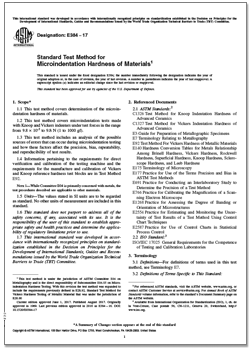英文名稱:
ASTM E384-17
Standard Test Method for Microindentation Hardness of Materials
中文名稱:
ASTM E384-17
材料顯微壓痕硬度的標(biāo)準(zhǔn)試驗(yàn)方法
替代情況:替代ASTM E384-16
代號(hào)說(shuō)明:
This standard is issued under the fixed designation E384; the number immediately following the designation indicates the year of original adoption or, in the case of revision, the year of last revision. A number in parentheses indicates the year of last reapproval. A superscript epsilon (ε) indicates an editorial change since the last revision or reapproval.
This standard has been approved for use by agencies of the U.S. Department of Defense.
版本說(shuō)明:
1 This test method is under the jurisdiction of ASTM Committee E04 on Metallography and is the direct responsibility of Subcommittee E04.05 on Microindentation Hardness Testing. With this revision the test method was expanded to include the requirements previously defined in E28.92, Standard Test Method for Vickers Hardness Testing of Metallic Material that was under the jurisdiction of E28.06
Current edition approved June 1, 2017. Published August 2017. Originally approved in 1969. Last previous edition approved in 2016 as E384 – 16. DOI: 10.1520/E0384-17
2 For referenced ASTM standards, visit the ASTM website, www.astm.org, or contact ASTM Customer Service at service@astm.org. For Annual Book of ASTM Standards volume information, refer to the standard’s Document Summary page on the ASTM website.
3 Available from International Organization for Standardization (ISO), 1, ch. de la Voie-Creuse, Case postale 56, CH-1211, Geneva 20, Switzerland, http:// www.iso.org.
標(biāo)準(zhǔn)正文:
1. Scope
1.1 This test method covers determination of the microindentation hardness of materials.
1.2 This test method covers microindentation tests made with Knoop and Vickers indenters under test forces in the range from 9.8 × 10 -3 to 9.8 N (1 to 1000 gf).
1.3 This test method includes an analysis of the possible sources of errors that can occur during microindentation testing and how these factors affect the precision, bias, repeatability, and reproducibility of test results.
1.4 Information pertaining to the requirements for direct verification and calibration of the testing machine and the requirements for the manufacture and calibration of Vickers
and Knoop reference hardness test blocks are in Test Method E92.
NOTE 1—While Committee E04 is primarily concerned with metals, the test procedures described are applicable to other materials.
1.5 Units—The values stated in SI units are to be regarded as standard. No other units of measurement are included in this standard.
1.6 This standard does not purport to address all of the safety concerns, if any, associated with its use. It is the responsibility of the user of this standard to establish appropriate safety and health practices and determine the applicability of regulatory limitations prior to use.
1.7 This international standard was developed in accordance with internationally recognized principles on standardization established in the Decision on Principles for the
Development of International Standards, Guides and Recommendations issued by the World Trade Organization Technical Barriers to Trade (TBT) Committee.
2. Referenced Documents
2.1 ASTM Standards:
C1326 Test Method for Knoop Indentation Hardness of Advanced Ceramics
C1327 Test Method for Vickers Indentation Hardness of Advanced Ceramics
E3 Guide for Preparation of Metallographic Specimens
E7 Terminology Relating to Metallography
E92 Test Method For Vickers Hardness of Metallic Materials
E140 Hardness Conversion Tables for Metals Relationship
Among Brinell Hardness, Vickers Hardness, Rockwell Hardness, Superficial Hardness, Knoop Hardness, Scleroscope Hardness, and Leeb Hardness
E175 Terminology of Microscopy
E177 Practice for Use of the Terms Precision and Bias in ASTM Test Methods
E691 Practice for Conducting an Interlaboratory Study to Determine the Precision of a Test Method
E766 Practice for Calibrating the Magnification of a Scanning Electron Microscope
E1268 Practice for Assessing the Degree of Banding or Orientation of Microstructures
E2554 Practice for Estimating and Monitoring the Uncertainty of Test Results of a Test Method Using Control Chart Techniques
E2587 Practice for Use of Control Charts in Statistical Process Control
2.2 ISO Standard:
ISO/IEC 17025 General Requirements for the Competence of Testing and Calibration Laboratories
在線閱讀 免費(fèi)下載







